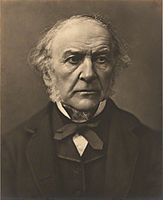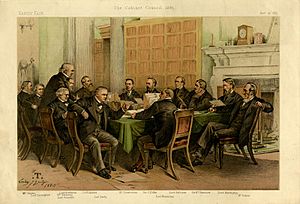Second Gladstone ministry facts for kids
Quick facts for kids Second Gladstone ministry |
|
|---|---|
| 1880–1885 | |

Gladstone (1879)
|
|
| Date formed | 23 April 1880 |
| Date dissolved | 9 June 1885 |
| People and organisations | |
| Monarch | Victoria |
| Prime Minister | William Gladstone |
| Total no. of members | 118 appointments |
| Member party | Liberal Party |
| Status in legislature | Majority |
| Opposition party | Conservative Party |
| Opposition leaders |
|
| History | |
| Election(s) | 1880 general election |
| Legislature term(s) |
22nd UK Parliament
lost a vote of confidence |
| Predecessor | Second Disraeli ministry |
| Successor | First Salisbury ministry |
The Second Gladstone Ministry was a government in the United Kingdom led by William Ewart Gladstone, who was the Prime Minister. It lasted from April 1880 to June 1885. Gladstone's Liberal Party won the 1880 general election after he spoke out against the previous government's foreign policies.
Even though another leader, Lord Hartington, was expected to become Prime Minister, he stepped aside for Gladstone. So, Queen Victoria asked Gladstone to form a government for the second time. His government worked on making changes to how Parliament worked. However, it became very unpopular after the death of General Gordon in 1885. Many people blamed Gladstone, and he resigned. This allowed the Conservatives, led by Lord Salisbury, to form the next government.
Gladstone's Cabinet: 1880-1885
Gladstone's cabinet was a group of important ministers who helped him run the country. They held key positions and made big decisions.
Here are some of the main roles and the people who held them during this time:
- First Lord of the Treasury and Leader of the House of Commons: This was the Prime Minister's main job, held by William Gladstone himself.
- Lord Chancellor: The chief legal advisor to the government, held by The Lord Selborne.
- Lord President of the Council: This person oversaw government departments and committees. It was held first by The Earl Spencer and then by The Lord Carlingford.
- Lord Privy Seal: This role involved keeping the King's or Queen's private seal and advising the monarch. It was held by The Duke of Argyll, then The Lord Carlingford, and finally The Earl of Rosebery.
- Home Secretary: This minister was responsible for law and order within the country. Sir William Harcourt held this job.
- Foreign Secretary and Leader of the House of Lords: This person handled relations with other countries. The Earl Granville was in this role.
- Secretary of State for the Colonies: This minister managed the British Empire's colonies around the world. The Earl of Kimberley and later The Earl of Derby held this position.
- Secretary of State for War: This minister was in charge of the army and defense. Hugh Childers and then Marquess of Hartington held this role.
- Secretary of State for India: This person oversaw British India. Marquess of Hartington and then The Earl of Kimberley were in charge.
- Chancellor of the Exchequer: This is the minister responsible for the country's money and taxes. William Gladstone held this role at first, then Hugh Childers took over.
- First Lord of the Admiralty: This minister was in charge of the Royal Navy. The Earl of Northbrook held this position.
- President of the Board of Trade: This minister looked after trade and industry. Joseph Chamberlain held this role.
- President of the Local Government Board: This minister was responsible for local government and public health. John George Dodson and then Sir Charles Dilke, Bt held this job.
- Chancellor of the Duchy of Lancaster: This was a special role, often given to a senior minister without a specific department. It was held by several people, including John Bright, The Earl of Kimberley, John George Dodson, and George Otto Trevelyan.
- Postmaster General: This minister was in charge of the postal service. Henry Fawcett and then George John Shaw-Lefevre held this role.
- Chief Secretary for Ireland: This minister was responsible for governing Ireland. William Edward Forster held this position.
- Lord Lieutenant of Ireland: This was the Queen's representative in Ireland. The Earl Spencer held this role.
Cabinet Changes Over Time
The people in the cabinet sometimes changed during Gladstone's government. Here are some of the main changes:
- In May 1881, Lord Carlingford took over as Lord Privy Seal from the Duke of Argyll.
- In April 1882, the Earl Spencer became Lord Lieutenant of Ireland. He kept his other job as Lord President at the same time.
- In May 1882, William Edward Forster resigned as Chief Secretary for Ireland. His replacement was not part of the main cabinet.
- In July 1882, the Earl of Kimberley became Chancellor of the Duchy of Lancaster, while also remaining Colonial Secretary.
- In December 1882, there were many changes:
- Hugh Childers became Chancellor of the Exchequer, taking over from Gladstone.
- Lord Hartington became Secretary for War, replacing Childers.
- Kimberley became Secretary for India, replacing Hartington.
- The Earl of Derby became Colonial Secretary, replacing Kimberley.
- John George Dodson became Chancellor of the Duchy of Lancaster, replacing Kimberley.
- Sir Charles Dilke became President of the Local Government Board, replacing Dodson.
- In March 1883, Carlingford became Lord President, while still being Lord Privy Seal. Spencer remained in the Cabinet as Lord Lieutenant of Ireland.
- In October 1884, George Otto Trevelyan became Chancellor of the Duchy of Lancaster.
- In March 1885, the Earl of Rosebery became Lord Privy Seal, replacing Carlingford. Carlingford remained Lord President. George John Shaw-Lefevre joined the cabinet as Postmaster-General.
Why the Government Ended
Gladstone's government faced a big challenge in 1885. General Gordon, a famous British officer, was killed in Sudan. Many people blamed Gladstone's government for not sending help sooner. This event made the government very unpopular.
Because of this, Gladstone's government lost a "vote of confidence" in Parliament. This means that enough members of Parliament no longer supported his government. When a government loses a vote of confidence, the Prime Minister usually has to resign. Gladstone did resign, and the Conservative Party, led by Lord Salisbury, then formed a new government.


